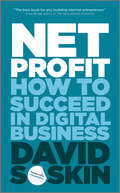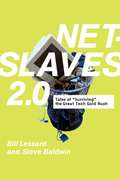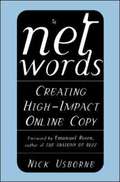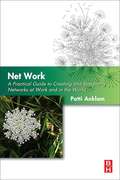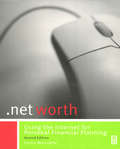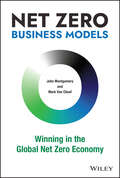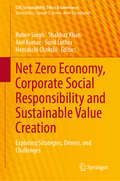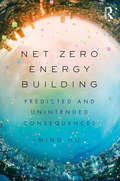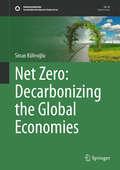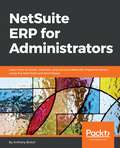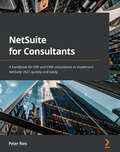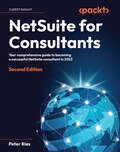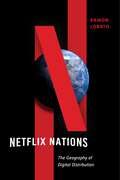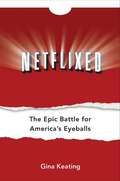- Table View
- List View
Net Profit
by David Soskin"This book has been written by an experienced entrepreneur who has built a highly successful online business. He understands the challenges first hand, and gives readers invaluable advice about the how they too can make it big in the digital world."--Luke Johnson, Chairman Risk Capital partners and Financial Times columnistOnline business can be a goldmine - or a minefield. David Soskin, former CEO of Cheapflights and Chairman of mySupermarket.co.uk, has faced all the problems thrown up by building a business on the Internet, and solved them. Here, he shows you how to:Convert a brilliant idea into something that actually paysGet the funding you need to expandBuild a great team of staff and advisersKeep the cash flowingGo global! Net Profit provides much needed inspiration and reassurance for would-be start ups and established businesses who want to do more online."I wish this book had been written ten years ago when I first entered the e-commerce industry."--Glenn Fogel, EVP - Corporate Development and International, Priceline.com"David Soskin combines the insightful mind of a top consultant, the hardened vision of a serial entrepreneur, and the practicality of a successful businessman. Read this book!" - Robin Buchanan, Adviser/Board member of multiple companies, previously the Dean and President of London Business School and also the UK Senior Partner of Bain & Company, the leading global consulting firm.
Net Slaves 2.0: Tales of Surviving the Great Tech Gold Rush
by Steve Baldwin Bill LessardTechnology professionals, former employees of failed Internet start-ups, downsized corporate workers, and entrepreneurs eager to avoid mistakes of the recent past will be captivated by this humorous and poignant account of the human cost of the dot.com rise and fall. In the sequel to their acclaimed and successful NetSlaves: Tales of Working the Web, the authors profile the people affected by the rise and fall of Internet companies and where they are today. The coverage in this collection of post-dot.com experiences includes the "survivalists", who made it through the storm intact and continue to work in the industry; the "neo-luddites", who have shunned the Internet forever; the "vigilantes", who are screaming for justice for their mistreatment; and many others. By revealing the most absurd moments of "the bubble" and what really happened to the people displaced by the death of the New Economy, this volume is essential reading for anyone who wants to know what these events mean for the future of the Internet industry.
Net Words: Creating High-Impact Online Copy
by Nick UsborneA practical guide on how to write online text that is funny, personal, engaging, and informative-in short, how to write text that people actually want to read. It gives insight on how to attract customers by online communication.
Net Work
by Patti AnklamPatti Anklam provides a guide for leaders and participants to work within and lead purposeful social networks “in the world.” Awareness of “networks” and “networked organizations” has reached the mainstream of the business publishing world, as evidenced in the increasing number of articles in such publications as the Harvard Business Review and the Sloan Management Review. Many graduate business school programs now teach social network analysis and network theory. Networks exist outside of corporations as well – everyone participates in multiple networks, including the informal family, community, work, and their purely social networks of friends. Formal networks include civic organizations like Rotary International, alumni groups, and business and professional groups. The latter have all evolved distinct governance models, norms for joining and participating, legacy databases, membership rolls, and very public identities. There is yet another class of network that is not yet well defined, and for which the norms and governance models are emerging--networks such as inter-company and intra-company learning and collaboration networks; independent consultants who share common interests and passions who want to remain independent but work collaboratively and consistently with like-minded others. They can be geographically local business networks; web-based virtual learning groups and communities; or global action networks destined to make the world a better place. The purpose of this book is to provide a taxonomy and guidebook to these “emergent” networks, with a specific focus on helping leaders and participants to create and sustain successful networks. It will address the need for articulating a governance model and norms, selecting and using appropriate tools, and expectations for how the network will grow and change over time.
Net Worth
by Carrie MaurielloFirst Published in 2001. Routledge is an imprint of Taylor & Francis, an informa company.
Net Zero Business Models: Winning in the Global Net Zero Economy
by John Montgomery Mark Van ClieafFuture-proof your business with net-zero emissions strategies that align with new economic realities In Net Zero Business Models: Winning in the Global Net Zero Economy, two accomplished business transformation thought leaders deliver a revolutionary new take on how to transition from business models that are contributing to worldwide climate disaster to net zero models consistent with long-term sustainability. In the book, you’ll discover what net zero emissions means, how to implement net zero emission business models, what the overall transition to a net zero emissions economy looks like, and, ultimately, how civilization itself will transition to net zero. The authors offer new processes and tools for diagnosing current business models and designing a viable transition to net zero. They establish a universal language for conversations about decarbonizing the economy by synthesizing business model design terminology and new integrated measurement and reporting statistics. Readers will also find: Accessible and comprehensible presentations of net zero emissions concepts, business models, and economies Concrete strategies for transforming existing business models into net zero-compatible models Frameworks for analyzing the consequences of conforming existing business models to a net zero emissions economyAn indispensable resource for executives, directors, and other business leaders, Net Zero Business Models is a one-stop, incisive discussion of how to successfully adapt to a new environmental and economic reality that is already here.
Net Zero Economy, Corporate Social Responsibility and Sustainable Value Creation: Exploring Strategies, Drivers, and Challenges (CSR, Sustainability, Ethics & Governance)
by Shahbaz Khan Anil Kumar Sunil Luthra Rubee Singh Hemakshi ChokshiThis edited volume brings together contributions from multiple experts in academia to explore the practical implications of the Net Zero Economy for corporate social responsibility and sustainable value creation in today's world. As the world approaches net-zero emissions by 2050, it is crucial for businesses to take corporate social responsibility seriously and make credible attempts to achieve sustainable value creation while reducing their greenhouse gas emissions. The book provides a comprehensive guide to navigating the complexities of corporate responsibility in the net-zero economy, drawing on the expertise of scholars in sustainable supply chain, environmental sciences, management, sustainable business management, and social sciences. With contributions from multiple experts, it examines the challenges that businesses face in reducing their climate impact and highlights the green growth opportunities that they can take advantage of in the net-zero transition. This edited volume is an essential read for students, research scholars, and industrial professionals working in sustainable development, eco-friendly business management, and corporate social responsibility.
Net Zero Energy Building: Predicted and Unintended Consequences
by Ming HuWhat do we mean by net zero energy? Zero operating energy? Zero energy costs? Zero emissions? There is no one answer: approaches to net zero building vary widely across the globe and are influenced by different environmental and cultural contexts. Net Zero Energy Building: Predicted and Unintended Consequences presents a comprehensive overview of variations in 'net zero' building practices. Drawing on examples from countries such as the United States, United Kingdom, Germany, Japan, Hong Kong, and China, Ming Hu examines diverse approaches to net zero and reveals their intended and unintended consequences. Existing approaches often focus on operating energy: how to make buildings more efficient by reducing the energy consumed by climate control, lighting, and appliances. Hu goes beyond this by analyzing overall energy consumption and environmental impact across the entire life cycle of a building—ranging from the manufacture of building materials to transportation, renovation, and demolition. Is net zero building still achievable once we look at these factors? With clear implications for future practice, this is key reading for professionals in building design, architecture, and construction, as well as students on sustainable and green architecture courses.
Net Zero, Food and Farming: Climate Change and the UK Agri-Food System (Earthscan Food and Agriculture)
by Neil WardThis book examines the implications of the net zero transition for food and farming in the UK and how these can be managed to avoid catastrophic climate change in the crucial decades ahead. For the UK to meet its international obligations for reducing greenhouse gas emissions, nothing short of a revolution is required in our use of land, our farming practices and our diet. Taking a historical approach, the book examines the evolution of agriculture and the food system in the UK over the last century and discusses the implications of tackling climate change for food, farming and land use, setting the UK situation in an international context. The chapters analyse the key challenges for this transition, including dietary change and food waste, afforestation and energy crops, and low-emission farming practices. This historical perspective helps develop an understanding of how our food, farming and land use system has evolved to be the way that it is, and draws lessons for how the agri-food system could evolve further to support the transition to net zero and avoid catastrophic climate change. Written in a clear and accessible style, this book will be essential reading to students and scholars of food, agriculture and the environment, as well as policymakers and professionals involved climate change policy and the agriculture and food industry.
Net Zero: Decarbonizing the Global Economies (Sustainable Development Goals Series)
by Sinan KüfeoğluThis monograph is designed to provide a comprehensive and accessible reference to Net Zero efforts globally. Firstly, the book explains the basics of Net Zero, Greenhouse Gas Emissions (GHG), and the global climate change struggle. A chapter on Environmental, Social, and Governance (ESG), as standardisation and screening of sustainability follows. Next comes a chapter on carbon pricing and carbon tax. After these background chapters, the book continues with eight chapters that cover Net Zero across a variety of economic sectors: energy supply, business sector, transport, residential, industrial processes, waste management, public (and government), and agriculture, forestry and land use. These economic sectors are adopted from the Intergovernmental Panel on Climate Change (IPCC) and UK National Statistics. Each chapter includes basic background information, technical or scientific, and a policy section. The sector-based chapters also include sectoral emissions analysis, review, and then a horizon scanning for innovative companies and their business models. This will enable non-experts from the business sector to read and understand the dynamics and trends in other sectors. Similarly, students and fresh graduates will easily follow the chapter (or the industry) that interests them and comprehend the basics and contemporary business trends. By joining research work with the business models of 400 noteworthy and innovative companies, this book constructs a vital bridge between academia, practical reality, policy, and business implementation, with a keen focus on environmental value.
NetApp
by Liz Kind Das NarayandasNetApp had undertaken an award-winning overhaul and upgrading of its channel strategy design that accounted for 46 percent of North America sales in 2006. Nonetheless, NetApp senior management announced they expected to grow revenue another 30% in fiscal 2007 with half the growth coming from channel sales. To meet those goals, a number of issues that had developed around the channel sales program would need to be addressed.
NetSuite ERP for Administrators: Learn how to install, maintain, and secure a NetSuite implementation, using the best tools and techniques
by Anthony BickofLearn steps and tasks to help a NetSuite administrator perform both his daily and monthly tasks efficiently. Advance his expertise to become NetSuite leader without having to spend time and money on corporate trainings.Key FeaturesUnderstand the business considerations and implementation of the NetSuite ERPGain a deep knowledge of enterprise security, data management, process automation, and analyticsLearn techniques to sail through system maintenance while ensuring accuracy and to practically troubleshoot issuesBook DescriptionNetSuite ERP is a complete, scalable cloud ERP solution targeted at fast-growing, mid-sized businesses and large enterprises. It's the smartly executed combination of financial management operations and built-in business intelligence, which enables companies to make data-driven and well-informed decisions. This book will help administrators become expert enough to be seen as the NetSuite leader at their company and to be able to advise department heads on specific processes, and strategic decisions. We start with an overview of ERP and NetSuite ERP, before going on to explain the built-in features to show the breadth of NetSuite ERP's product and its ease of use. We then discuss business aspects, focusing on the most important processes in NetSuite. Then you'll understand the implementation aspects that are generic enough to cover all the features. The focus then shifts to specific skills that you will need to administer for any system, such as roles, permissions, customization, and data imports. Moving on, you'll learn how to centralize the creation of search templates and give users the tools to pivot the data and expose it to the user in useful ways, such as on the dashboard. The book ends with checklists providing actionable steps that you as an administrator can take to do your job and support the application through new releases and troubleshooting problems.What you will learn Provide executives with meaningful insights into the business A Framework to streamline the implementation of new and existing features Leverage built-in tools to optimize your efficiency and effectiveness Test configuration to check the implementation of role-specific permissions Understand how to optimize the amount of data to be shared with users Import data like new leads and employ current data like pricing updates Perform on-going maintenance and troubleshoot issuesWho this book is forThis book is for administrators, consultants, and Project Managers who would like to improve their skills in the areas of configuration and system management. Basic experience implementing NetSuite is assumed.
NetSuite for Consultants: A handbook for ERP and CRM consultants to implement NetSuite 2021 quickly and easily
by Peter RiesGet hands-on with NetSuite implementation, customization, and integration services for automating operations and accelerating business growthKey FeaturesUnderstand how to consult a new client from the kick-off meeting to their go-live and beyond in the fastest possible timeExplore the new features in NetSuite 2021 and learn best practices for ERP and CRM consultantsAvoid the common pitfalls that consultants can run into when implementing NetSuiteBook DescriptionNetSuite For Consultants takes a hands-on approach to help ERP and CRM consultants implement NetSuite quickly and efficiently, as well deepen their understanding of its implementation methodology.During the course of this book, you'll get a clear picture of what NetSuite is, how it works, and how accounts, support, and updates work within its ecosystem.Understanding what a business needs is a critical first step toward completing any software product implementation, so you'll learn how to write business requirements by learning about the various departments, roles, and processes in the client's organization. Once you've developed a solid understanding of NetSuite and your client, you'll be able to apply your knowledge to configure accounts and test everything with the users. You'll also learn how to manage both functional and technical issues that arise post-implementation and handle them like a professional.By the end of this book, you'll have gained the necessary skills and knowledge to implement NetSuite for businesses and get things up and running in the shortest possible time.What you will learnUnderstand the NetSuite ecosystem, including its main modules, the platform, and related featuresExplore the fundamentals of NetSuite and get ready to implement it in any organizationDiscover how to manage gaps, data migration, and integrations with NetSuiteFind out how to minimize disruptions in finance as you migrate to NetSuiteUnderstand the steps to configure your organization's account and how development and testing fit into the implementation scheduleRefine your skills with NetSuite tips and tricks and make each implementation process a successWho this book is forThis book is aimed at consultants, NetSuite users, and partners who are tasked with guiding the organizations to get their business up and running with NetSuite. Basic NetSuite training and a general understanding of its features is required to get the most out of this book.
NetSuite for Consultants: Your comprehensive guide to becoming a successful NetSuite consultant in 2023, 2nd Edition
by Peter RiesGuide clients through a NetSuite implementation with the latest features in 2023 including gathering requirements, setting up the basics, creating custom automations, and importing data with SuiteQLKey FeaturesPick up the best ways to identify a client's needs by asking the right questions in the initial interviews.Explore the new features in NetSuite 2023, including the Supply Chain Control Tower for managing inventory and gathering performance reports.Avoid pitfalls and get the implementation right first time by following the advice of a Consulting Technical Director at Oracle NetSuite.Book DescriptionERP and CRM consultants can effectively implement NetSuite for a client organization with the aid of NetSuite for Consultants, revised with the latest features and best practices for NetSuite 2023. After reading this book, you'll have a thorough understanding of how to configure the NetSuite ecosystem for any business. You'll learn how to apply new features such as the Manufacturing Mobile application, NetSuite budgeting features, and tools for handling rebates and trade promotions. This edition also includes expanded coverage of technical topics such as SuiteQL and the SuiteTalk REST API. Understanding what a business requires is a crucial first step toward completing any software product deployment, and this NetSuite guide will teach you how to ask meaningful questions that ascertain which features, basic and new, you will need to configure for your client. Most importantly, you'll not only learn how to perform a NetSuite implementation; you'll also learn how to prepare clients to use the software confidently, which is the true test of a great consultant.What you will learnUnderstand the NetSuite ecosystem, including the platform and its primary modules, and associated featuresLearn how to gather and document requirements, including understanding an organization's industry, transactions, and peopleLearn about the methodologies that go into creating a project plan for a NetSuite implementationFulfill client requirements with expanded coverage on managing employees, customer projects, and budgetingDiscover how to create custom automations and perform data migration with SuiteQL scriptsPerform integrations with expanded coverage on how we use the REST API for business purposesRecognize the procedures for testing and developmentRefine your skills with NetSuite tips and tricks and make each implementation process a successWho this book is forThis book is aimed at new NetSuite consultants who are tasked with guiding an organization through their NetSuite implementation. To make the most out of this book, you are expected to have already completed the basic NetSuite Foundations training course.
Netflix
by Stephen P. Kaufman Willy Shih David SpinolaReed Hastings founded Netflix with a vision to provide a home movie service that would do a better job satisfying customers than the traditional retail rental model. But as it encouraged challenges it underwent several major strategy shifts, ultimately developing a business model and an operational strategy that were highly disruptive to retail video rental chains. The combination of a large national inventory, a recommendation system that drove viewership across the broad catalog, and a large customer base made Netflix a force to be reckoned with, especially as a distribution channel for lower-profile and independent films. Blockbuster, the nation's largest retail video rental firm, was initially slow to respond, but ultimately rolled out a hybrid retail/online response in the form of Blockbuster Online. Aggressive pricing pulled in subscribers, but at a price to both it and Netflix. But a new challenge was on the horizon: video-on-demand. How should Netflix respond?
Netflix
by E. Scott MayfieldThe CEO of a successful Internet start-up must decide whether to delay the company's initial public offering following a significant decline in the NASDAQ market during the spring of 2000. The company's CFO is asked to reevaluate the company's projected cash flow needs in light of the new requirement that in order to go public, Internet companies must show positive cash flows within a 12-month horizon. While examining ways to extend the company's working capital, the CFO considers various changes to the company's existing business model, including changes in the company's contractual relationships with both its suppliers and its customers.
Netflix Nations: The Geography of Digital Distribution (Critical Cultural Communication #28)
by Ramon LobatoHow streaming services and internet distribution have transformed global television culture.Television, once a broadcast medium, now also travels through our telephone lines, fiber optic cables, and wireless networks. It is delivered to viewers via apps, screens large and small, and media players of all kinds. In this unfamiliar environment, new global giants of television distribution are emerging—including Netflix, the world’s largest subscription video-on-demand service.Combining media industry analysis with cultural theory, Ramon Lobato explores the political and policy tensions at the heart of the digital distribution revolution, tracing their longer history through our evolving understanding of media globalization. Netflix Nations considers the ways that subscription video-on-demand services, but most of all Netflix, have irrevocably changed the circulation of media content. It tells the story of how a global video portal interacts with national audiences, markets, and institutions, and what this means for how we understand global media in the internet age.Netflix Nations addresses a fundamental tension in the digital media landscape – the clash between the internet’s capacity for global distribution and the territorial nature of media trade, taste, and regulation. The book also explores the failures and frictions of video-on-demand as experienced by audiences. The actual experience of using video platforms is full of subtle reminders of market boundaries and exclusions: platforms are geo-blocked for out-of-region users (“this video is not available in your region”); catalogs shrink and expand from country to country; prices appear in different currencies; and subtitles and captions are not available in local languages. These conditions offer rich insight for understanding the actual geographies of digital media distribution. Contrary to popular belief, the story of Netflix is not just an American one. From Argentina to Australia, Netflix’s ascension from a Silicon Valley start-up to an international television service has transformed media consumption on a global scale. Netflix Nations will help readers make sense of a complex, ever-shifting streaming media environment.
Netflix in 2011
by Stephen P. Kaufman Willy ShihReed Hastings founded Netflix to provide a home movie service that would do a better job satisfying customers than the traditional retail rental model. But as it encountered challenges it underwent several major strategy shifts, ultimately developing a business model and an operational strategy that were highly disruptive to retail video rental chains. The combination of a large national inventory, a recommendation system that drove viewership across a broad catalog, and a large customer base made Netflix a force to be reckoned with, especially as a distribution channel for lower-profile and independent films. Blockbuster, the nation's largest retail video rental firm, was initially slow to respond, but ultimately rolled out a hybrid retail/online response in the form of Blockbuster Online. Aggressive pricing pulled in subscribers, but at a price to both it and Netflix. But a new challenge was on the horizon - the rapid growth of the company's online streaming service, which had a very different business model. Hastings' efforts to separate the activity into two separate companies met with strong pushback from consumers and the press. What was the best path forward?
Netflix: A Creative Approach to Culture and Agility
by Ranjay Gulati Allison M. Ciechanover Jeff HuizingaBy 2018, Netflix had been credited for revolutionizing how viewers consumed entertainment-shifting from ad-fueled linear network programming to a highly personalized, on-demand, all-you-can-consume, ad-free model. The company was riding a long wave of revenue and subscriber growth as it expanded internationally and into original production. From its earliest days, Netflix leadership had fostered a workplace characterized by such values as excellence, maturity, transparency, accountability, candor, and autonomy. The Culture Deck, later dubbed the Culture Memo, documented how Netflix's culture had evolved and enabled the organization to repeatedly innovate, disrupt, and pivot. The case examines the company's history and delves into ways leadership continues to nurture its unique culture through an emphasis on concepts such as "freedom and responsibility," "context, not control," and "highly aligned, loosely coupled." The case allows students to assess CEO Reed Hastings' view that the culture is capable of further scaling even as headcount surges and the company continues its expansion into new geographies and even more content production.
Netflix: A Creative Approach to Culture and Agility (B)
by Matt Higgins Ranjay GulatiThis B case, set in summer 2022, was designed as a companion to "Netflix: A Creative Approach to Culture and Agility," a case set in 2018. The purpose of this brief document is to unlock a discussion around how the Netflix culture can be used to weather new challenges facing the company: rising competition, economic contraction, and declining subscribers.
Netflix: Designing the Netflix Prize (A)
by Karim R. Lakhani Greta Friar Wesley M. Cohen Kynon Ingram Tushar Kothalkar Maxim Kuzemchenko Santosh Malik Cynthia Meyn Stephanie Healy PokrywaIn 2006, Reed Hastings, CEO of Netflix, was looking for a way to solve Netflix's customer churn problem. Netflix used Cinematch, its proprietary movie recommendation software, to promote individually determined best-fit movies to customers. Hastings determined that a 10% improvement to the Cinematch algorithm would decrease customer churn and increase annual revenue by up to $89 million. However, traditional options for improving the algorithm, such as hiring and training new employees, were time intensive and costly. Hastings decided to improve Netflix's software by crowdsourcing, and began planning the Netflix Prize, an open contest searching for a 10% improvement on Cinematch. The case examines the dilemmas Hastings faced as he planned the contest, such as whether to use an existing crowdsourcing platform or create his own, what company information to expose, how to protect customer privacy while making internal datasets public, how to allocate IP, and how to manage the crowd.
Netflix: Designing the Netflix Prize (B)
by Karim R. Lakhani Wesley M. Cohen Kynon Ingram Tushar Kothalkar Maxim Kuzemchenko Santosh MalikThis supplemental case follows up on the Netflix Prize Contest described in Netflix: Designing the Netflix Prize (A). In the A case, Netflix CEO Reed Hastings must decide how to organize a crowdsourcing contest to improve the algorithms for Netflix's movie recommendation software. The B case follows the contest from the building of the platform in 2006 to the awarding of the highest prize in 2009. The B cause also considers the aftermath of the contest, and the issues of successfully implementing a winning idea from a contest.
Netflix: Valuing a New Business Model
by Michael Norris Francois Brochet Suraj SrinivasanIn autumn 2011, Netflix was working to right the ship after publicly stumbling through a price hike and strategic shift and then retreat. The company was changing its business model to focus on streaming video service rather than the DVDs by mail that had brought the company success and praise. One important wrinkle in this business model shift came in the accounting of streaming content. The case describes the rule, FAS 63, that Netflix used to account for streaming content, and the implications for the future of the company that could be attributed to this accounting shift.
Netflixed
by Gina KeatingThe history of Netflix is a long struggle for greatness marked by multiple disasters, lucky breaks, personal betrayal, and broken hearts. It has more drama than most of the movies Netflix rents. Netflix has come a long way since 1997, when two Silicon Valley entrepreneurs, Marc Randolph and Reed Hastings, decided to start an online DVD store before most people owned a DVD player. They were surprised and elated when launch-day traffic in April 1998 crashed their server and resulted in 150 sales. Today, Netflix has more than 25 million subscribers and annual revenues above $3 billion. Yet long- term success—or even survival—is still far from guaranteed. Journalist Gina Keating recounts the absorbing, fast-paced drama of the company’s turbulent rise to the top and its attempt to invent two new kinds of business. First it engaged in a grueling war against video-store behemoth Blockbuster, transforming movie rental forever. Then it jumped into an even bigger battle for online video streaming against Google, Hulu, Amazon, and the big cable companies. Netflix ushered in such innovations as DVD rental by mail, a patented online queue of upcoming rentals, and a recommendation algorithm called Cinematch that proved crucial in its struggle against bigger rivals. Yet for all its success, Netflix is still a polarizing company. Hastings is often heralded as a visionary—he was named Business Person of the Year in 2010 by Fortune—even as he has been called the nation’s worst CEO. Netflix also faces disgruntled customers after price increases and other stumbles that could tarnish the brand forever. The quest to become the world’s portal for premium video on demand will determine nothing less than the future of entertainment and the Internet. Drawing on extensive new interviews and her years covering Netflix as a financial and entertainment reporter, Keating makes this tale as absorbing as it is important. .
